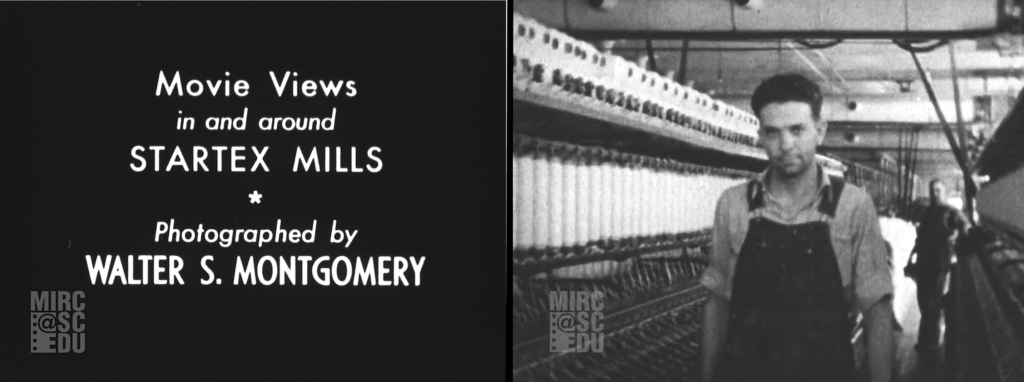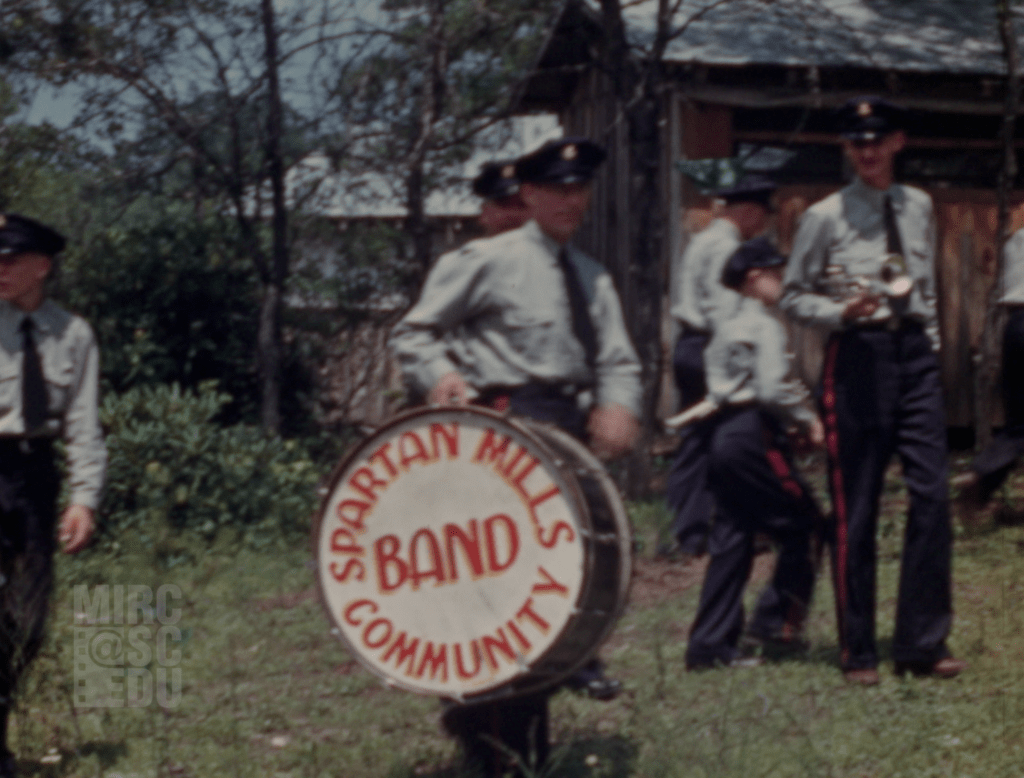Threads of Social Change: Walter S. Montgomery’s Mill Village Films
by Anthony Gonzalez (NYU MIAP) & Kimberly O’Quinn (UofSC MIRC)
The films we screen at the Orphan Film Symposium come from the Walter S. Montgomery Collection at the University of South Carolina’s Moving Image Research Collections. Throughout his life, Montgomery was an avid amateur filmmaker, shooting family and travel films as well as industrial films about the textile industry. These two films depict daily work and life in “Montgomeryville,” a mill village community near Spartanburg, South Carolina. The state’s textiles sector pivoted from agriculture towards industrial processing during the early twentieth century. Mill owners built villages to attract workers and their families from the mostly agrarian countryside. Mill villages became insular communities with their own schools, general stores, and churches. They played a key role in the development of an industrial working class, both as an economic class and a subculture distinct from other interests in the Piedmont (in the northwest corner of the state).
Startex: Men and Women at Work and Play shows both labor and social activities at the Startex Mills, which Montgomery purchased in 1936. An opening title card proudly proclaims “STARTEX KITCHEN TOWELS ARE SOLD EVERYWHERE IN THE UNITED STATES,” as the film steps through their manufacture.
 Millworkers operate the machinery used to produce the towels, starting from raw cotton and ending with packing for shipment. Their labor is inscribed into a larger industrial transformation as spinning machines and automatic looms replace spinning and weaving thread by hand. Workers’ labor becomes anonymized, attributed to the Startex brand rather than to their own hand.
Millworkers operate the machinery used to produce the towels, starting from raw cotton and ending with packing for shipment. Their labor is inscribed into a larger industrial transformation as spinning machines and automatic looms replace spinning and weaving thread by hand. Workers’ labor becomes anonymized, attributed to the Startex brand rather than to their own hand.
The millworkers’ labor appears mechanical. Yet, the film also shows that their hard work was rewarded with fulfilling recreation. The mill’s men and women’s baseball teams practice on the village diamond. Several male employees attend a dinner held in a social hall. The company provides spaces for both work and socializing — and sets the terms for both.

To supplement Startex, we screen excerpts from Spartan Mill as a Community. The hour-long piece features vibrant color footage of Montgomeryville. The millworkers throw picnics with lush buffet lines. A company brass band performs. Children and adults play baseball. Women and children tend to a communal garden. Millwork has brought Montgomeryville’s residents together, but they have woven a strong social fabric that extends beyond their status as wage laborers.
Montgomery was president of Spartan Mills at the time he made these films. For him, shooting footage was a form of play that intertwined with his work. Both films feature shots where millworkers line up to smile and wave for the camera. These illustrate the millworkers’ complex social negotiation between their employer and their community. What role is Mr. Montgomery playing behind the camera? Is he acting as a supervisor, a friend, a benefactor, or some mix of these?
Today, company towns such as Montgomeryville are described as forms of industrial paternalism. Mill companies would extend these benefits to their employees as a way of increasing millworkers’ dependence upon their employer. The social and material benefits of working at Startex were contingent upon employment in the mill. Losing a job meant risking eviction.
Company towns were and are exploitative practices, Startex and Spartan Mills as a Community challenge this framing to reveal something more complex: a community that developed out of a close negotiation between industrial labor and social formation.
The Walter S. Montgomery Collection consists of 173 films (108 16mm prints, fifteen 8mm and fifty Super 8) shot by Montgomery Sr. (1900-1996), president of the Spartan Mills textile company (1934-1972). The footage dates from ca. 1926 to 1987. It includes home movies, travel films, and amateur industrial documentaries. In 2022, MIRC received a grant from the National Film Preservation Foundation to preserve three films from this collection, including Spartan Mill as a Community as well as two documenting American delegations visiting European textile mills (England 1944, 30 min. and France 1945, 14 min.). Link to all 4 titles in the MIRC catalog, with streaming video of each.
Filmography
Startex: Men and Women at Work and at Play
(Walter S. Montgomery Sr., US, 1938)
16mm, black-and-white, silent, 12 min.
Source: University of South Carolina, Moving Image Research Collections
Spartan Mill as a Community
(Walter S. Montgomery Sr., US, ca.1938)
16mm, color and black-and-white, silent, 1 hour
Source: University of South Carolina, Moving Image Research Collections
Featured image (at top):
Sparta Cotton Mill, Spartanburg, S.C. (1909) Haines Photo Co., panoramic photograph, 10 x 30 in. Library of Congress Prints and Photographs Division, www.loc.gov/item/2007662772. The copyright title seems to be in error. Sparta Cotton Mill was in Sparta, Georgia. However, the photograph is likely of Spartansburg’s Spartan Mill three decades before Montgomery shot these films. Haines Photo Company photographed three other cotton mills in Spartanburg in 1909.
p.s.
In 1994, South Carolina ETV broadcast the documentary “Mr. Walter”: The Life and Times of Walter S. Montgomery, Sr., which makes extensive use of his home movies. He was 94 years old at the time.
